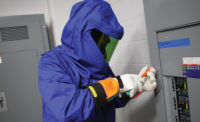Electrical safety risks are prevalent in any industry that has workers who are exposed to over 50 volts of electricity when performing a work task.
What types of industries and businesses are most prone to arc flash and electrical safety risks? Electrical safety risks are not specific to a particular industry or more prevalent in any type of business, but rather, those businesses and industries that have workers who are exposed to over 50 volts of electricity when performing a work task. Commonly, this risk is relegated to certain types of workers, such as electricians and maintenance staff, but other groups of workers cannot be excluded from the list based on the roles and responsibilities an organization assigns. Electrical risk should not be looked at as an industry-specific issue, but looked at on a task-by-task basis.
Factors such as turnover, budgets, time and knowledge all play a role in the story of why an organization is at the level of risk it’s at as it pertains to electrical safety.
What are the most common obstacles for businesses to overcome when achieving NFPA 70E compliance?
Lack of awareness and education on the latest NFPA 70E standard are issues we address the most when working with businesses to reach a higher level of compliance to OSHA and NFPA 70E standards. NFPA 70E continually updates its regulations every three years to improve worker safety, however, not all businesses react to the ever-changing standards internally. Outside resources need to be brought in to ensure the latest updates and protocols for safe electrical work are instructed to their qualified electrical workers so that they can learn how to properly navigate such requirements and standards on their own. The lack of knowledge, experience and skill in comprehending these safety standards can leave employees vulnerable to dangers they don’t recognize.
Other key factors that often impact NFPA 70E compliance is buy-in within an organization, which may inhibit a comprehensive employee training program, and ultimately, safety on the job. In addition, time and financial resources are factors that overwhelmingly determine the route an organization follows. When making decisions on critical components for a safe working environment, such as comprehensive employee training, the type and depth of the training can be sacrificed due to limited resources. The NFPA 70E standard is long, detailed and changes on a routine basis. The electrical safety training program an organization selects must reflect the robust nature of the standard. If organizations sacrifice on the crucial aspect of employee training, its employees may have a varied interpretation or lack of understanding and knowledge on how to protect themselves when engaged in electrical tasks, such as shutting off power or equipping workers with appropriate tools or personal protection equipment (PPE).
What are the benefits of conducting an arc flash risk assessment?
For organizational leaders such as facility, maintenance and safety managers who are not sure if their facilities are at the level of compliance, or are considering ways to ensure their qualified electrical workers have an understanding of the hazards they work with, conducting an arc flash risk assessment is a critical first step and can benefit an organization by:
- Understanding the Incident energy of electrical devices – A comprehensive, engineered arc flash risk assessment should include a Short Circuit Study, Device Coordination Study, Device Interrupt Rating and Evaluation, as well as recommendations to mitigate the potential for an arc flash. This will clearly highlight whether an organization’s equipment is properly rated to withstand a short circuit current and if the protective devices that are in use have the capacity to handle short circuit currents without creating additional hazardous conditions. Labeling electrical devices within a facility also occurs during the assessment to clearly outline critical safety information communicated to the qualified electrical worker prior to exposure to the hazardous energy to provide real-time safety warnings for workers. Gaining insight into proper PPE requirements – The output of the Arc Flash/Incident Energy Analysis accurately calculates the incident energy and arc flash boundaries. These calculations are used as the basis for the Arc Flash labels and key to determining the specific arc-rated clothing and minimum PPE requirements that qualified electrical workers need to don prior to exposure to opening electrical devices to commence the task.
- Keeping formal documentation of results and recommendations – At the end of an arc flash risk assessment, companies will receive a full written analysis of the assessment and thorough list of mitigation recommendations to ensure they adhere to current OSHA and NFPA 70E standards moving forward.
- Maintaining a strong safety culture and improving efficiency in the long term – After executing a baseline arc flash risk assessment, and then making necessary updates when new equipment is installed or when existing equipment is modified or moved every five years, organizations can feel confident that revisions to the NFPA 70E or NEC (National Electric Code) standards – which occur every three years – are captured and incorporated by updating and including arc flash labels for new equipment as well as updated drawings. Businesses with a thorough electrical safety program are not only investing in the safety and wellbeing of their employees, but also improving the efficiency of their facility operations and ultimately, the company’s bottom line.
What are some crucial focus areas when it comes to electrical safety training and NFPA 70E compliance?
With arc flash and other electrical hazards posing dangerous risks to employees, it’s vital to have strong electrical safety practices in place before these types of incidents occur. Focus areas to develop a first-rate electrical safety program include:
- Skills training for qualified workers – Ensuring that employees have the proper electrical safety training they need before an incident occurs is one of our safety experts’ top recommendations. Following an arc flash risk assessment, organizations should consider implementing an internal qualified worker program that includes both classroom and hands-on training of the qualified worker’s specific tasks. The training program can be customized to the organization and individual based on the specific tasks they are engaged in, which will outline the risks associated with the specific electrical tasks or optimal compliance and performance. This shall be done every 3 years or if changes in an employee’s duties warrant additional skills training.
- Updating arc flash risk assessments and labeling – Keeping track of industry requirements and updates can be difficult to manage, which is why organizations should conduct arc flash risk assessments every five years at minimum. If updates to the electrical system are made or equipment is added, an arc flash risk assessment should be performed upon completion of those changes. Consistent updates are critical for organizations to achieve NFPA 70E compliance and to ensure safe working conditions for their employees before an incident occurs.
- Engaging third-party partners – The most objective and accurate evaluation of an electrical safety program is done by outside resources, so organizations should engage a third-party to complete an arc flash risk assessment, electrical training and site-specific audits. If considering third parties to assist in your electrical safety program, third party resources should be able to:
- Follow the most current NFPA 70E standard (2021).
- Perform on-site data collection and label application without the need for assistance by the host organization.
- Utilize current measurements and system observations – versus old data – for inputs into the risk assessment study.
- Employ professional engineers experienced in power systems studies to accurately model the system and conduct the arc flash study.
- Complete the arc flash study with a comprehensive report on the power system, provide recommendations on mitigation, and apply the arc flash labels to the equipment.
- Adhere to a high standard of the administration and teaching of electrical safety not only in compliance with NFPA 70E, but also have the ability to customize training to your organization.
Note: This information is intended to help guide facilities and its personnel. However, proper implementation, training and compliance is the responsibility of the facility and its operators.



